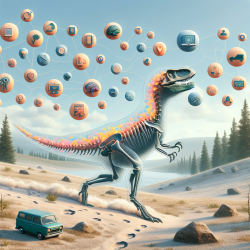Introduction
The study of dinosaur locomotion, particularly focusing on the architecture of cancellous bone in theropods, offers fascinating insights into how these ancient creatures moved. The research paper titled Cancellous bone and theropod dinosaur locomotion. Part I—an examination of cancellous bone architecture in the hindlimb bones of theropods provides a comprehensive analysis of the 3D architecture of cancellous bone in theropods, drawing parallels with modern species and offering insights into their biomechanics.
Understanding Cancellous Bone Architecture
Cancellous bone, also known as spongy bone, is highly sensitive to its mechanical environment. This study used computed tomographic and image analysis techniques to describe the three-dimensional architecture of cancellous bone in theropods for the first time. The findings reveal that more stemward non-avian theropods exhibit cancellous bone architectures similar to humans, while species closer to birds show patterns akin to extant birds.
Implications for Practitioners
For practitioners in fields such as physical therapy, biomechanics, and education, these findings can be transformative. Understanding the biomechanics of extinct species can inform the development of therapeutic techniques and educational tools that mimic natural evolutionary processes. Here are some ways practitioners can leverage this research:
- Biomechanical Modeling: Use insights from theropod biomechanics to develop models that can predict movement patterns in humans and animals, aiding in rehabilitation and physical therapy.
- Educational Tools: Incorporate findings into educational materials to help students understand evolutionary biology and biomechanics, enhancing engagement and learning outcomes.
- Therapeutic Techniques: Develop new therapeutic techniques that mimic natural locomotor biomechanics, potentially improving outcomes for patients with mobility issues.
Encouraging Further Research
The study highlights the potential for further research into the biomechanics of extinct species. Practitioners are encouraged to explore the following areas:
- Comparative Studies: Conduct comparative studies between extinct and extant species to further understand the evolution of locomotion.
- Advanced Imaging Techniques: Utilize advanced imaging techniques to explore the cancellous bone architecture in other extinct species, providing a broader understanding of their biomechanics.
- Interdisciplinary Collaboration: Collaborate with paleontologists, biomechanists, and educators to develop comprehensive models that can be used across disciplines.
Conclusion
The research on theropod locomotion offers valuable insights that can be applied across various fields. By understanding the biomechanics of these ancient creatures, practitioners can enhance their skills and develop innovative solutions in therapy, education, and beyond. The study serves as a reminder of the interconnectedness of life, past and present, and the continuous evolution of knowledge.
To read the original research paper, please follow this link: Cancellous bone and theropod dinosaur locomotion. Part I—an examination of cancellous bone architecture in the hindlimb bones of theropods.










